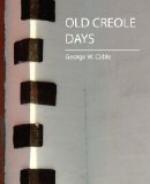The second Saturday afternoon following was hot and calm. The lamp burning before the tabernacle in Pere Jerome’s little church might have hung with as motionless a flame in the window behind. The lilies of St. Joseph’s wand, shining in one of the half opened panes, were not more completely at rest than the leaves on tree and vine without, suspended in the slumbering air. Almost as still, down under the organ-gallery, with a single band of light falling athwart his box from a small door which stood ajar, sat the little priest, behind the lattice of the confessional, silently wiping away the sweat that beaded on his brow and rolled down his face. At distant intervals the shadow of some one entering softly through the door would obscure, for a moment, the band of light, and an aged crone, or a little boy, or some gentle presence that the listening confessor had known only by the voice for many years, would kneel a few moments beside his waiting ear, in prayer for blessing and in review of those slips and errors which prove us all akin.
The day had been long and fatiguing. First, early mass; a hasty meal; then a business call upon the archbishop in the interest of some projected charity; then back to his cottage, and so to the banking-house of “Vignevielle,” in the Rue Toulouse. There all was open, bright, and re-assured, its master virtually, though not actually, present. The search was over and the seekers gone, personally wiser than they would tell, and officially reporting that (to the best of their knowledge and belief, based on evidence, and especially on the assurances of an unexceptionable eye-witness, to wit, Monsieur Vignevielle, banker) Capitaine Lemaitre was dead and buried. At noon there had been a wedding in the little church. Its scenes lingered before Pere Jerome’s vision now—the kneeling pair: the bridegroom, rich in all the excellences of man, strength and kindness slumbering interlocked in every part and feature; the bride, a saintly weariness on her pale face, her awesome eyes lifted in adoration upon the image of the Saviour; the small knots of friends behind: Madame Thompson, large, fair, self-contained; Jean Thompson, with the affidavit of Madame Delphine showing through his tightly buttoned coat; the physician and his wife, sharing one expression of amiable consent; and last—yet first—one small, shrinking female figure, here at one side, in faded robes and dingy bonnet. She sat as motionless as stone, yet wore a look of apprehension, and in the small, restless black eyes which peered out from the pinched and wasted face, betrayed the peacelessness of a harrowed mind; and neither the recollection of bride, nor of groom, nor of potential friends behind, nor the occupation of the present hour, could shut out from the tired priest the image of that woman, or the sound of his own low words of invitation to her, given as the company left the church—“Come to confession this afternoon.”
By and by a long time passed without the approach of any step, or any glancing of light or shadow, save for the occasional progress from station to station of some one over on the right who was noiselessly going the way of the cross. Yet Pere Jerome tarried.




